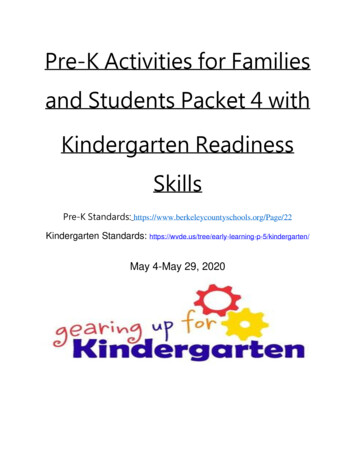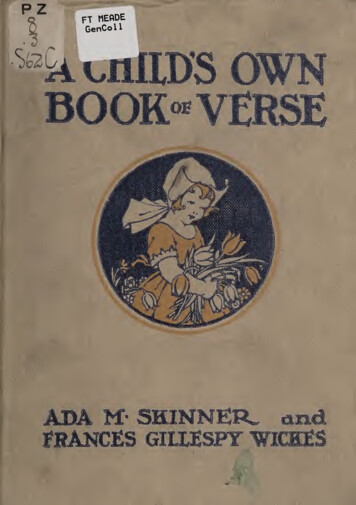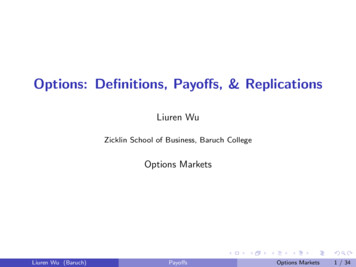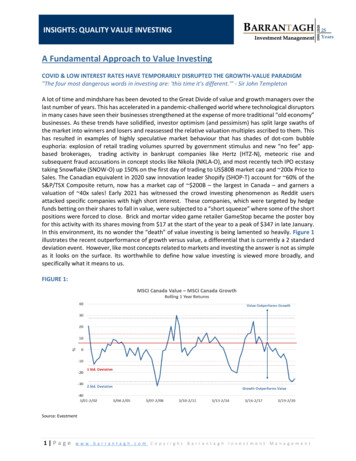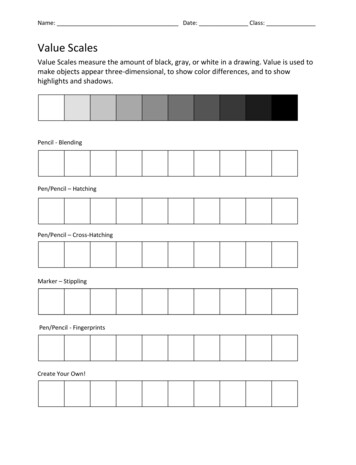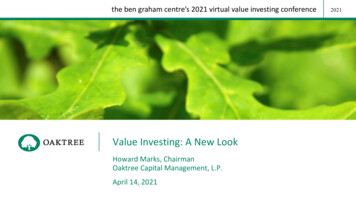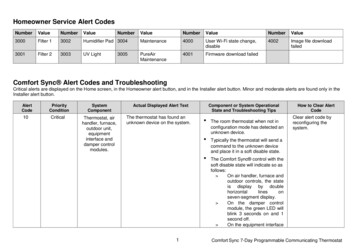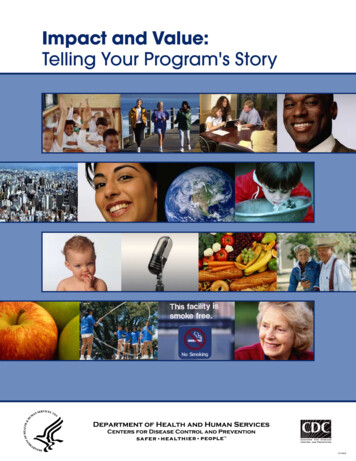
Transcription
Impact and Value:Telling Your Program's StoryCS108628
IMPACT AND VALUE:TELLING YOUR PROGRAM’S STORYLessons Learned from the Division of Oral Healthand Its PartnersAuthors:S. René Lavinghouze, MAEvaluation ScientistDivision of Oral HealthCenters for Disease Control and PreventionRlavinghouze@cdc.govAnn W. Price, PhDConsultantCommunity Evaluation ntributors:ECB, Inc.2824 Livsey TrailTucker, GA 30084ecbservices@comcast.netDavid P. Hoffman, MEdExpert Consultant to the Office of Policy Evaluation and Legislation (OPEL)3 West Albany, New York 12204Phone (518) 474-1222Fax (518) 473-0642dph01@health.state.ny.usFor more information see www.cdc.gov/oralhealth or contact René Lavinghouze atRlavinghouze@cdc.gov.Suggested Citation:Centers for Disease Control and Prevention. Impact and Value: Telling your Program’s Story.Atlanta, Georgia: Centers for Disease Control and Prevention, National Center for Chronic DiseasePrevention and Health Promotion, Division of Oral Health, 2007.i
ii
TABLE OF CONTENTSPART I : TELLING YOUR PROGRAM’S SUCCESS STORYWho is the Audience for this Document? .What Is a Success Story? . .Why Do You Want a Success Story? . . .Types of Success Stories Based on the Phase of the Program .Choosing the Correct Format . . . .How to Develop an Effective Success Story. . . .Lessons Learned . Putting It Together: Formatting the Success Story .Typical Outline of the One-Page Success Story. .Summary .Success Story Criteria .Example of Applied Format: Arkansas and Community Water Fluoridation .112468182125262728PART II : SUCCESS STORY COLLECTION TOOL AND EXAMPLES OFSUCCESS STORIESIntroduction .Success Story Data Collection Tool Using a Success Story for Multiple Audiences .Final Reminders .CDC Division of Oral Health .Resources . . .iii293033434446
INDEXSample Success StoriesPart IArkansas: Preventing Tooth Decay by Strengthening the Community WaterFluoridation Program . 28Part IIColorado’s Chopper Topper School-based Sealant Program Helps ChildrenSucceed in School (Audience: Educators) . 34Colorado: “Chopper Topper”—Providing Dental Sealants in Schools(Audience: Health Professionals) . . 36Alaska: Preventing Dental Problems through Surveillance in the“Great Land” (Audience: Stakeholders and Decision Makers) 38Finished product—Multiple formats . Assessment in the “Great Land” (Audience: Stakeholders and 48iv40
PART ITELLING YOUR PROGRAM’S STORYWho Is the Audience for This Document?The purpose of this workbook is to help public health program administrators understandwhat a “success story” is, why it is important to tell success stories, and how to developsuccess stories. This document is intended to be used by program managers/coordinators inorder to provide steps they can use to systematically collect and create success storiesthat highlight their program achievements. The document was written by the staff of theDivision of Oral Health (DOH) at the Centers for Disease Control and Prevention (CDC)and, therefore, the examples come from DOH. However, the content and steps for collectingand writing success stories can be applied to any public health program. Part I of thisworkbook defines success stories, discusses several types of success stories and their uses,and offers several methods for systematically collecting success stories. Part II of thisworkbook includes a template that can be used to collect success stories and severalexamples of success stories from DOH grantees.What Is a Success Story?Who can resist a picture of a smiling child who is now pain-free because her teeth have beenrestored and sealed to prevent further decay? After all, this is the purpose of your program—to change the lives of participants for the better. Such a simple description of a program’sprogress, achievements, or lessons learned is a success story.With varying levels of evidence, a success story shows movement in your program’sprogress over time, its value and impact. More importantly, a success story serves as avehicle for engaging potential participants, partners, and funders. With attention to detail,a system of regular data collection and practice, this tool can become a powerful instrumentto spread the word about your program.1
Success stories come in all shapes and sizes but probably the most familiar is the “onepager,” of which we have included examples in Part II of this workbook. The format of thestory and the type of story used depends on your audience and your moment of opportunity.When tailoring your success story you need to consider the following questions: What is a success story? What is the developmental stage of the program? What type of format is most appropriate for the story and audience? How will the story be collected?To be truly ready for the moment of opportunity, you will need to have a full complement ofsuccess stories at your disposal.Why Do You Want a Success Story?A success story in its many formats isa basic tool you should have in yourcomprehensive “tool box” of productsCollecting success stories affords theopportunity to regularly step back andcelebrate achievements both big and small.used to promote your program and tellyour story. You are essentially “selling” your program when you seek new partners,stakeholders, funders, and participants for your program. Successful salespeople will tell youthat you should a) have a comprehensive set of selling materials, and b) have these toolsready and with you at all times so that you don’t miss out when opportunity knocks.Success stories are no different. They can be used: In response to public inquiries about the program. To educate decision makers. To demonstrate that funds are well spent. To make the target population aware of your program. To show movement in program progress when planned outcomes will not berealized until the distant future. To help mobilize resources. To help your program get needed resources.2
By collecting and developingsuccess stories, you can involveand engage the entire programSuccess stories are an effective meansto move beyond the numbers andconnect to your reader; a cause they canrelate to and want to join.staff and help everyone to focuson program goals. Collecting success stories affords the opportunity to regularly step backand celebrate achievements both big and small.While not your main method of presenting data, success stories contribute an effectiveelement to an overall evaluation plan. Admittedly, there often is an inherent bias in theselection of success stories. However, they do have a place in your evaluation efforts,especially in the early, pre-outcome data stages. Success stories can facilitate thedocumentation of both intended and unintended program effects and provide information thatcan be used to publicize early achievements. Success stories put a “face to the numbers” ofsurveillance, research, and evaluation data by bringing to life a program’s impact at the streetlevel. What does it really mean when you report that you have provided “X” amount ofservices to “Y” amount of people? How are the lives of the program participants changedbecause of your services?Having a systematic method for collecting and using success stories will allow you to haveup-to-date information at your fingertips. The process affords another benefit outside theuses of program promotion: The process of collecting success stories facilitates learning forall staff. For example, higher-level management staff may not fully understand what ishappening at the program level. Success stories help you promote your work to othermembers of the staff who may not be aware of all that you do. The potential uses for successstories are almost endless.3
Types of Success Stories Based on the Phase of the ProgramUpstream Success StoriesYour program is in its early stages. You have neither achieved your planned outcomes norsubstantiated or rejected your proposed logic model (a graphic representation of theprogram).* At this point, you want to verify the program description, highlight anypartnerships, document policy changes as a result of the program, and/or illustrate whom theprogram is serving. Partner publications may serve some of your needs while you aredeveloping your strategies, and your stories may emphasize national and/or state level dataduring this phase.Midstream Success StoriesWith your program up and running, you want your partners to know about your progress.You haven’t achieved the long-range outcomes yet, but you have some promising stories andexamples of early changes. You may now have anecdotal, change-on-the-street type ofstories to share. Your success story may spotlight community changes and growth of theprogram as well as partners. National and/or state level data may still constitute the bulk ofsupport for you model; however, preliminary program data should indicate you are makingprogress. Look to your process evaluation (an evaluation of who the program serves and towhat extent) to provide data that can be used in your midstream success story. These storiestypically include both data and anecdotal information.*A Logic Model Development Guide is available from the W.K. Kellogg Foundation at http://www.wkkf.org.4
Downstream Success StoriesBy now, life-on-the-street has changed. You have demonstrated impacts that you want toconvey to your stakeholders. Your success story should illustrate how things have changedfor the people your program serves. You are not eliminating surveillance data. Rather, thegoal is to explain surveillance systems’ results to a general audience. For example, whatdoes it mean that 30% of your state’s most at-risk population now has access to or hasreceived sealants? The goal is to catch the attention of your audience and leave them wantingmore information.5
Choosing the Correct FormatYour purpose in telling your story and the audience you wish to target will determine yoursuccess story’s format. Your story for that chance meeting in the elevator will most certainlybe different from the one you’ve prepared for a potential funding opportunity.Elevator StoryYou are on the elevator returning from a coalition meeting when opportunity walks throughthe door in the form of your health officer. She politely asks how you are doing. This is thetime to grab her attention with a brief taste of your program and promise more to come at alater date. This is your moment of opportunity! This is not the time to ad lib. You must bearmed and ready with your best 10-second story. By successfully negotiating this moment ofopportunity, you caught her attention and promised her a more comprehensive report that youwill be happy to drop off at her office later that day. Your story is important. Your job is tomake sure decision makers focus on it. You never know when opportunity will knock, so beprepared!Paragraph SpotlightPartner publications, newsletters, newspapers, and other media sources routinely requestsmall items to fill “news holes.” Sometimes these requests come far in advance and allowyou ample time to develop your story. More often than not, an editor simply needs one moreparagraph to fill a newsletter, and he needs it by 5:00 p.m. today. If you’re ready, thenewsletter will spotlight your program. If you aren’t, another program will fill the void, andyou will have missed your opportunity.6
One-PagerThe common one-pager provides a powerful way to catch the attention of policy makers,funders, and other decision makers who are inundated with information and requests for theirtime. A polished document that speaks to the heart of your program can make the differenceon whether or not your story gets read or put in the circular file. Use pictures to complete thestory and include partner logos to demonstrate your collaborative efforts. Always be sure toinclude your contact information. You want your audience to know where to look for moreinformation.Two-Page Success StoryA two-page story that provides more detail than a one-page story can be used to present amore complete picture of your program. A two-page story can be used as a best practicesubmission or to highlight a specific state program. Several organizations have excellentexamples of two-page stories on their Web sites. CDC’s Office on Smoking and Healthprovides examples of two-pagers developed by states to preserve tobacco control funding inan environment where budget cuts threaten their programs.Sustaining State Funding for Tobacco Control (see Resources and Products: state snapshots):http://www.cdc.gov/tobacco/tobacco control htm7
Full BriefBy using your elevator story, paragraph spotlight, and one and two-page stories, your issuehits the “radar screen,” or you receive a formal request for information. You need aneffective brief. If you haven’t considered this type of tool, you may not have enough time todevelop it. You have your audience’s attention; this is your time to shine. This format usespictures, surveillance data, and graphs as well as anecdotal stories to portray your issue andshowcase program achievements.Published ArticleThe public recognizes the public health issue you are addressing and increasingly supportsyour efforts. By synthesizing your work and experiences, others can learn from your programand replicate it in their communities.How to Develop an Effective Success StoryIn order to develop effective success stories, you must beas conscientious about collecting your stories as you areabout collecting surveillance data. Success stories must bereliable, valid, and available at a moment’s notice.In order to develop effectivesuccess stories, you must beas conscientious aboutcollecting your stories as youare about collectingsurveillance data.Developing a reliable and valid success story requires a plan that includes the following: A data collection tool. A plan for collecting both formal and informal stories. Staff responsible for collecting, organizing, analyzing, and writing the stories. A communication plan for disseminating the stories. A plan for developing a story repository.8
Who Is the Audience for a Success Story?Identify your audience before you begin to write your story. Your audience includes anybodywho is a potential partner, such as a funder or a community member, who could help withprogram implementation. For example, a partner may be: Major business industries in your state Civic organization Policy makers¾ Federal elected officials¾ Federal management¾ State elected officials¾ State appointed officials¾ State management¾ Local officials Schools or universities Media sourcesThe list of potential partners is endless. However, it is important to keep in mind that yourstory or stories must be geared toward your audience. Knowing what kind of informationyour target audience needs and desires will help you to develop the most effective successstory.Identify the issues that concern your target audience. If your issue is not among them, youmay consider collaborating with a program that is “on the radar screen.” For example, apartnership between an obesity program and an oral health program or collaboration betweenan oral cancer program and an oral health program could be among the more powerful andtimely partnerships you may consider.9
Develop a System for Collecting Success StoriesTo be effective, the plan to collect and use successstories must be intentional. Success stories cannot becollected haphazardly or at the last minute. Your firstTo be effective, the plan tocollect and use success storiesmust be intentional.step is to create a system that makes collecting success stories routine. To ensure timely andconsistent implementation, you need a written, systematic plan with methods, timelines, andcheckpoints. Be thoughtful about your timelines and the timelines of your audience.For example, if your identified target audience comprises policy makers, be aware of how abill becomes a law, how the budget is set, and the legislative calendar.Program staff often neglect “additional” duties related to program evaluation because theyare so busy with everyday tasks. You must assign success story collection duties to specificprogram staff at the outset. The actual resources needed depend upon the collection methodsand the story formats chosen. Start with a core working group to develop a sound plan andidentify the personnel for this project. The plan should include assigning data collection,story development, and communication strategy responsibilities. Remember to plan with theend in mind. Do you want to turn your collection of success stories into a book of stories ona regular basis to be used to market your program? Will you use the stories in your programevaluation? Will you include the stories in monthly newsletters?Elements of a Plan for Collecting Success Stories: Develop a system for collecting success stories.Identify collection methods and tools.Create and/or identify resources.Organize your stories.10
Identify Collection Methods and ToolsYou may collect success stories in numerous ways. The methods you choose will determinethe resources needed as well as the types and depth of information you can collect. We willdiscuss three categories of collection methods to get you started: the Success Story WatchSystem, official solicitation, and the stakeholder forum (program or professionally led).Three Ways to Collect Success Stories: Success Story Watch System Official solicitation Stakeholder forumThe Success Story Watch SystemThis method sets you on the hunt for information contained in regularly occurring formats orforums. This may include a systematic review of partner publications, newspapers, programreports, and presentations. Be sure to assign a person the responsibility for taking notes aboutpotential success stories that are discussed informally at coalition meetings, conferences,or other group meetings. You can return to the source of the story later for details and contextif needed. Develop a standard format for compiling your information. This will alert youto where you are missing data elements and enable you to return to the source formore information.Official Solicitation of Success StoriesYou may also informally or formally solicit success stories from partners, stakeholders,program participants, and others interested in your program. Informally, you may emailrequests for stories to your listserve on a periodic basis. Include a collection form when yousolicit stories. (An example of a form is provided in Part II of this document). This will helpthe respondent know exactly what kind of information you need. Again, store the storysubmissions in a systematic way and check for missing data elements before the storybecomes dated.11
On a formal basis, you may require grantees and sub-grantees to submit success stories withtheir annual reports. In addition, program staff or a professional group leader could conduct aforum.Stakeholder Forum: Program-LedIf your budget is limited and you plan to conduct the forum yourself, King and Stevahn (indevelopment) offer the suggestions provided below for “do-it-yourself” data collection.Three-Step Interview: As people enter the room, divide them into groups of three. Have ahandout with discussion questions ready. Each person takes a turn “interviewing” anothermember while the third person listens and takes notes. After the “interview,” the membersswitch roles until each person has had a turn as interviewer, speaker, and note taker.Data Dialogue: When people enter the room, divide them into groups of three. In this caseeach person receives a handout but answers the discussion questions themselves. They takenotes on the handout and discuss their answers as a group. Any new information is recordedby the group members. The discussion sheets then are collected and used later for dataanalysis.Graffiti Technique: Have Post-It notes ready. When stakeholders arrive, divide them intogroups of three to four people. Use a question to get the discussion started. For example:“In the last year, what are some specific examples of our coalition’s success?” Then givethem a set amount of time, about 5 minutes, to generate as many examples of success as theycan, recording one idea per Post-It note. Each person should write his or her own notes.Everyone then should post their examples on large sheets of papers for each discussionquestion. These sheets are collected later for data analysis.12
Concept Formation: This is a continuation of the Graffiti Technique. Have group membersorganize the Post-it notes into concepts or themes. This should generate a lot of discussion;group members will have to work together to achieve consensus.Cooperative Rank Order: Continuing the Graffiti Technique and Concept Formation, havegroup members work together to rank their results in the order of importance from mostimportant example of success to least important.Professionally-Led Stakeholder ForumFor programs that have sufficient budget, the professionally-led stakeholder forum (while themost resource-intensive method for collecting stories) can bring the greatest reward. Thewatchword for ensuring a return on your investment is “planning.” The stakeholder forumbrings together a targeted group of people with an interest in your program for the specificpurpose of discussing success stories. This method often yields benefits in addition tocollecting stories; it offers the opportunity for you to really listen to your stakeholders.In turn, they have the opportunity to feel that they have been heard. Since this forum onlyfocuses on program successes, it allows everyone to take a step back from the daily concernsof the program and put the work in perspective. As one grantee recognized in one session,“We are making steps, even if they are baby steps.”Participants benefit by hearing about other programs. Participants are inspired by otherparticipants’ stories as one story may triggerWhatever method you use, the keyto developing meaningful and usefulsuccess stories is collecting them ina systematic way.another person’s memory that would nothave been considered in response to aformal solicitation. An additional benefit ofthe process is that the stories collected often have a greater range and depth than thosegathered through formal solicitations. In addition, spontaneous collaborations often developduring the forum session.13
Whatever method you use, the key to developing meaningful and useful success stories iscollecting them in a systematic way. Collect success stories at regular intervals throughactivities designed specifically to solicit stories. In addition to your regular systematicmethod of collection, establish a mechanism for impromptu story submissions. Send regularreminders to staff and coalition members to send in stories and provide a template to collectthese in an electronic file. Provide training at the local level on how to develop and usesuccess stories. Ultimately, this will result in better state-level stories.In 2005, the CDC’s Division of Oral Health (DOH) contracted with ECB Services, Inc. toconduct stakeholder forums at ten of the grantee sites funded through CooperativeAgreement 03022, “Support for State Oral Disease Prevention Programs,” and to produceone-page success stories. ECB collaborated with DOH evaluation staff to design andimplement the stakeholder forums. Examples of the stories that resulted from this project areincluded in Part II of this workbook. This section highlights the steps used in conducting thisseries of stakeholder forums.Steps Used in Conducting Stakeholder Forums: Pre-visit preparationPre-session meetingConducting the sessionSession follow-up1. Pre-visit preparation: Determine audience, determine major points, and extendinvitations. As we stated above, you should already have determined your audience andmajor points for this session during your planning stages. Armed with this information, youcan determine whom to invite to participate. It may not be appropriate for all the membersof your coalition to be present if you are focusing on one specific program area. Invitethose who best know the stories and/or who would benefit from participating in the session.For example, if you want to know exactly how a dental sealant program has changed thelife of participants, you need to include some program participants and not just the programcoordinators.14
Take steps to help things run smoothly. Send reminders about the meeting one or two weeksprior to the date. Conduct a pre-site visit conference call to prepare the meeting coordinators.During the conference call, address the following planning items: Explain the purpose of the stories and exactly how they will be used. Identify who will be involved in the forum session. Identify any pre-existing documentation that may be useful for understanding context. Explain the process of conducting the story discussions. Inform coordinators of the potential for follow-up contact for missing information orclarification. Discuss some of the potential benefits that you have experienced with other groups(e.g., spontaneous collaborations, morale boosts, information sharing). Discuss logistics. Do you need a flip chart, markers, seating arrangements,refreshments, etc.?It’s a good idea to have a follow-up call to ensure that invitations and responses areproceeding on schedule. In addition, conduct one last pre-visit call two to three days prior tothe session to make sure that all the elements for a successful forum are in place.2. Pre-session meeting. Meet with coordinators prior to the session. You mayconsider having dinner together the night before. In this relaxed atmosphere, the coordinatorshave the opportunity to get to know the facilitators and be reassured about the purpose ofthe meeting and how the information to be collected will be used. During this meeting,facilitators can learn more about the context of the meeting and about those people who areinvited to participate. In addition, this meeting provides an opportunity to address last-minutelogistical problems.3. Conducting the session. Arrive early the day of the meeting and make sure thebuilding and room are clearly identified. Check the room and ensure the equipment is readyand in good working order. Be sure and check the recording devices. Begin the session byintroducing your facilitators and explaining the purpose and use of the data to be collectedduring the forum. Tell the group that they will be focusing on successes, big and small.15
If the meeting will be recorded, you should obtain participant consent and inform themwhether they may speak off the record. Let everyone know who will have access to theinformation you are gathering. Even though you are focusing on successes, participants maybe suspicious of sharing their data and wary of how it will be used. This concern usuallyfades quickly as the discussion progresses. Discuss whether or not you will be taking picturesand obtain consent for using them. Try to create an environment that is relaxing (allowadequate time; select a convenient, comfortable space; serve refreshments).Have a set of well-defined questions to prompt the discussion. However, beware of havingtoo many questions. If you do not allow time for spontaneous storytelling, or the “quiltingbee effect,” you will shortchange the range and depth of the stories. Allow participants thetime to share and be inspired by the other participants’ stories. Encourage all participants totake part in the discussion. Don’t be shy about showing nonverbal enthusiasm for the stories.The facilitator is not a scientist with a clipboard in hand during this forum. This tells theparticipants that you are excited for them. But do try to keep your own comments to aminimum so that the participants have the time to give you as many stories as possible. Thisis their time to shine; the forum can be a great morale booster.16
Examples of some starter questions are provided below. In the answer to everyquestion, make sure that the respondent specifies the who, what, when, where, why,and how of the program.1. What has changed in the way you do business because of this program since(insert date here)?a. Be sure to give a date reference.b. Change the words to be participant-specific.2. What are you most proud of when you go home at night?a. Follow up with context questions.b. Probe for details related to exactly what led to this achievement.3. Has your work received any recognition or rewards?a. What kinds of awards and for what aspect of the program were theawards given?b. What agencies or organizations gave the awards?c. Where was the awards program initiated?These types of questions work best when you are looking for general success stories withouta specific focus in mind. If you do have a focus, such as successes related to a particularstream of funding or aspect of the program, make sure to incorporate these details into yourquestions as well as your introductory remarks. It is very important to be clear about whatyou are looking for prior to engaging in the stakeholder forum. You cannot expect a bountifulharvest if you cast your seeds wherever the wind blows.To conclude the session, be sure to recognize all that the participants have accomplished.Point out that they just demonstrated how the work they do matters!
and writing success stories can be applied to any public health program. Part I of this workbook defines success stories, discusses several types of success stories and their uses, and offers several methods for systematically col
